The Memorial Clock Tower:
Through 75 Years and Beyond
- — Table of Contents —
- • Memorial Clock Tower Celebrates 75 Years
- • First Rocks Brought In For Memorial Tower
- • Recollections of Edwina (Cork) Harris
- • Recollections of Eleanor (Cork) Mack
- • Recollections by Gordon W. Kenny
- • Remembering the Unveiling
- • Winnie Alexander Had This To Say
- • Chester Zajic Remembered Things This Way
Written
and with photos and interviews
contributed by
Erika Foley
© 2005
- Browse Photos: Below
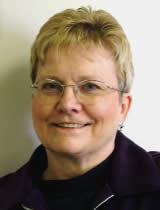
Erika Foley
Educator, Historian and Journalist
Browse Photos: Above | Next • Table of Contents • Top •
Memorial Clock Tower Celebrates 75 Years
This piece first
appeared September 29, 2000 in,
Town Clock 75th Anniversary,
Supplement to the Wainwright Star Chronicle.
Seventy five years ago, on September 13, 1925 the people of Wainwright and district gathered around the clock and dedicated it, and a plaque with 33 engraved names, to the memory of those from the area who gave their lives in the first World War of 1914-1918.
On July 30, 1947 another gathering was held to honor another 28 locals who parished in the second World War of 1939-1945. Some of those who died in this war had brought rocks for the construction of the clock, and had taken part in the first dedication in 1925. Their names were now on the second plaque.
Each Remembrance Day citizens of Wainwright, along with the Royal Canadian Legion, gather around this memorial and pay tribute to those who fell in the wars.
Seventy five years after that initial dedication, on September 30, 2000, the people of Wainwright and district will once more gather around this clock to celebrate that anniversary, and again remember just what the memorial town clock stands for.
For seventy five years this memorial town clock has stood in the centre square of main street and second avenue - a landmark by which people all over the world know our community. We are known as the town with the town clock in the middle of main street. To some it might just be a traffic hazard, but to others it is a permanent part of Wainwright that serves to remind us of family, or war and sacrifice, and of peace.
For a grand total of $3500.00 Frank and William Bailey built this monument for the Walter Musson Chapter of the Imperial Order Daughters of the Empire and the Town of Wainwright. It was on Sept. 19, 1921 that the I.O.D.E. first approached the town council asking for permission to erect some kind of memorial at the intersection of present day main street and second avenue.
On April 13, 1922 a delegation of I.O.D.E. members approached the council setting forth the form of the memorial and council then endorsed their action and commended their efforts for a suitable memorial to the soldiers of this town who fell in the Great War.
A Memorial Committee of councillors Fish, Yaeger and Huntingford were appointed to work with the local branch of the I.O.D.E.
In the Feb. 14, 1923 edition of the Star, there is mention of the I.O.D.E. holding their annual ball.
“ The large attendance proved that the people of the town and district appreciate the efforts of the chapter in their attempt to furnish the town with a suitable memorial to those who made the supreme sacrifice in the great war. It is hoped that the effort of last Monday evening will furnish them with sufficient money to erect the town clock which we understand has already been purchased and waiting erection. ”
Browse Photos: First (#1) | Below (#1b) | Skip Photo (Part 1B) • Table of Contents • Top •
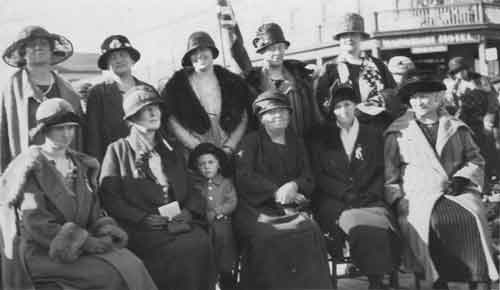
Seated on the ceremony platform are, in top row, Mrs. McDougall, Mrs. L. Bean, Mrs. G. Hudson, Mrs. Church, Mrs. Smith; in bottom row, Mrs. J. Welch, Mrs. P.D. Laird (Sr.), Mrs. C.B. Turner, Mrs. H.Y. Pawling and Mrs. Lasell. At center is the young Walter Huntingford.
* Please see footnote on this photo at end of page.
Imperial Order
Daughters of the Empire
at Commemoration Ceremony
September 13, 1925.
Photo: Earl L. Cork *
Browse Photos: Above (#1b) | Next (#2) • Top • Table of Contents •
Memorial Clock Tower Celebrates 75 Years, continued…
A communication from Mrs. Lasell, I.O.D.E. Regent, concerning the
installation of the master clock in the council chamber was ordered filed
in the minutes of July 4, 1923. On August 2, 1923 the council gave
permission to the Walter Musson Chapter I.O.D.E. to use the 15 foot space
for the erection of the memorial in the centre of main street and second
avenue.
The June 4, 1924 edition of the Star mentions that the War memorial Tower fund was augmented by the proceeds of a concert and two act play.
“ We understand that the net result of the affair will be something over $100, and this will bring down the amount required to complete the memorial to a very small sum. ”
In the June 25, 1924 edition mention was made that the I.O.D.E. held an open air dance and another nice donation to the memorial fund was realized. In the same paper, an article advertised the “ Stone Bee ” to be held July 7 and 8, when farmers were asked to bring in loads of stones and deposit them besides the restroom. The ladies were to supply coffee and sanwiches for all those bringing in loads of stones.
A section in the July 9, 1924 Star read,
“ It is noteworthy that nearly twenty loads of stone were brought into town for the memorial at the beginning of the week. As this is about one -half of that required, other loads will be truly welcomed by the side of the restroom. ”
There was a request by the I.O.D.E. in the March 4, 1925 Star for obtaining a complete list of the soldiers from the district who died overseas in the late war. Mention was made of having a bronze tablet engraved at an early date.
The town minutes from July 3, 1925 state that a motion was made to grant $100 to the I.O.D.E. for the finishing of the Memorial Clock Tower.
From the Sept. 9, 1925 Star:
“ After many months of worry and work on the part of the Walter Musson Chapter I.O.D.E., their efforts in the erection of a suitable memorial for those ‘ who went and came not again ’ in the Great War are to be brought to a successful termination. On Sunday next Major Gen. W. Griesbach of Edmonton will unveil a bronze memorial tablet set into the masonry of the clock tower, and the structure will be dedicated as a fitting and lasting monument to the worthy names with which it is adorned and in whose memory it is erected.
“ It is proposed that the school children will be in attendance as well as the returned men of the district, and the guard of honor for the distinguished visitors is to be furnished by the local Alberta Dragoons. ”
On Sunday, September 13, 1925 the untiring efforts of the I.O.D.E.,
“ were brought to a
successful conclusion, when the Memorial Clock Tower and the bronze
tablet theron were dedicated to the memory of those heroes who went
from our midst and came not again. ”
The September 16, 1925 Star front page covers the celebration in great
description. This continues on page four of the paper.
As we gather around the clock again this September 30, let us remember those, who over seventy five years ago, helped to create this wonderful memorial. The town clock is still standing for their children and grandchildren today, as it will be for our children and grandchildren seventy five years from now, and even further ahead in time. Let us help preserve our heritage by never forgetting the past, and always looking ahead to the future. We will remember them forever!
• Top • Table of Contents •
First Rocks Brought In For Memorial Tower
In a letter to Herb Snyder in November, 1980, former area resident Ron Morrison writes:
“Again, about the clock, I was visiting at Greenshields one winter, I can’t remember which one, but I think it was 1923, and Donald McDougal said that the I.O.D.E wanted field stones, so we got a sleigh load and dumped them in the centre of the block back of where the Legion hut was set up, near the derelect tractor that was used by the farmers as a hitching post. so I helped bring in the first load.”
Browse Photos: Previous (#1b) | Below (#2) • Skip Photo (Part 3) • Table of Contents • Top •
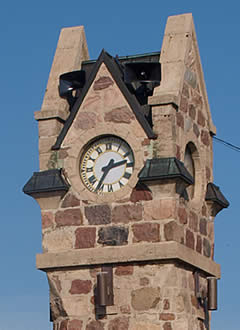
West Clockface in 2010
Showing carillon added previous to town centennial
Browse Photos: Above (#2) | Next (#3) • Top • Table of Contents •
Recollections of Edwina (Cork) Harris
What follows here, and the in next part are excepts from letters written to long time Wainwright resident Herb Snyder by Edwina and Eleanor, granddaughters of Mrs. A. Lasell, Regent of the Walter Musson Chapter of the Imperial Order Daughters of the Empire in 1925, and daughters of Earl Cork, C.N.R. watch inspector and Mayor of Wainwright in 1925. Here Edwina writes,
I was 13 years old when the memorial clock tower was dedicated on September 13, 1925, so I can remember a lot of things about it. The idea of the clock tower originated in the minds of those dedicated women of the I.O.D.E. Grandma was Regent at the time, so I remember when the idea was born. They wanted to build a war memorial - it had to be a project everyone could take part in - something from the land the men had left - something useful, that future generations could look up to. Today, you can see what they co-operatively came up with. No one person can take the credit, I am sure.
The organization worked in many ways to raise the money. Every Saturday the women put on a dinner in the Oddfellows Hall and everyone that brought in a load of rocks sat down to a delicious home cooked meal. They did this, until the day Mr. Bailey said, “No more!” As it was a Saturday (no school) and lots of good smelling food around, the ladies found many helpful recruits in my age group to run errands. I remember what good cooks they had, especially Mrs. Welch and Mrs. Turner. Garden vegetables, meat and fowl were generously donated by the town’s people and farmers that had them to spare. Even very young children gathered stones and brought them in. Of course, Mr. Bailey could not use much of these, but the spirit of co-operation was there. How I wish we had more of that spirit today. Wainwright should be proud of their memorial and it’s origin - I know I am.
The clock itself was purchased from Gillett & Johnston, Croydon, England through my Dad, at cost. He installed the master clock in the town hall and maintained it for many years as his contribution to the memorial. It had a few bad times, as in the 1929 fire, but over all it survived healthy and strong and Dad enjoyed looking after it.
The bronze tablet, set in the masonry, was designed by Major Norburg, of Edmonton. Mr. F. Bailey was the builder; he was hesitant about taking on the job but was finally persuaded by the ladies. I have faint recollections of seeing blue prints of the “Roman” tower but I can’t recall who designed it - it could have been Mr. Bailey - I’m not sure. According to the Star, the entire monument cost $3500.00
The dedication day was a “big” day for Wainwright - all the school children were present, everyone was there - except me. I had scarlet fever. It was with mixed emotions I listened to the proceedings from my bedroom. I’m not sure if it really was a warm day or my fever, but I had the window wide open and could hear the band and the applause quite clearly. I think now, my illness was a “fortunate misfortune,” as the girl who took my place, was far more deserving of the honor. Bessie Bowerman had lost her father in the war. They told me afterwards that my school chum did the job beautifully.
As you know we lost everything in the fire of 1929, but my Dad had sent pictures, program and a copy of the Star to his mother. All these have come back to me so I am sending them to you. Dad took the picture of the active I.O.D.E. members at the ceremony and their names are on the back. The Star is dated September 16, 1925, has all the speeches front page only, but a fairly complete report and readable.
I hope this will be of help to you, it is one of the pleasures of life to be able to share pleasant memories with others.
Edwina Harris, November 1980
• Top • Table of Contents •
Recollections of Eleanor (Cork) Mack
Eleanor penned this in her letter to Herb Snyder.
About the monument - I too remember the blue print. It was spread out all crackling new and the grownups were very excityed - in our back shop. I recall that the stone mason from the old country was reluctant to build the tower as he had a farm north of town and couldn’t or didn’t want to leave it for so long as it took to build the tower. They had to convince him. I believe it was Frank Bailey, but Edwina would remember it more clearly that I.
Eleanor Mack, February 1981
Browse Photos: Previous (#2) | Below (#3) • Skip Photo (Part 5) • Table of Contents • Top •
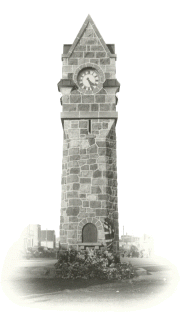
Twenty-six minutes past four…
September 13, 1925
Once the crowds had cleared, William Carsell shot this commemorative photo which he prepared in 8 x 10 portrait fashion, with handwritten label, “Memorial Clock Tower”.
Photo: W.M. Carsell
Browse Photos: Above (#3) | Next (#4) • Top • Table of Contents •
Recollections by Gordon W. Kenny
Gordon was the son of Nicholas and Lottie Kenny who were early settlers in the Wainright district - N.E. 34-44-6. He was the first boy born in Wainwright (April 19, 1909). N.S. Kenny was the mayor of Wainwright from 1920-1921, and town secretary-treasurer from 1931-1944; his mother was a charter member of the I.O.D.E. The following are excerpts from a letter he wrote to Herb Snyder in July, 1981.
The reason my mother was not in the snapshot of the ladies of the I.O.D.E. at the time of the dedication of the Clock Tower was that she was in Ontario visiting her parents. This was a dissapointment to her. The I.O.D.E. was a very hardworking, dedicated group of ladies and it is correct that my mother was very active and worked hard in all the group’s efforts. Mrs. Lasell was a wonderful lady and very much respected.
The Clock Tower idea for a memorial was selected because it was felt that it would be a most fitting memorial in that it would stand in the centre of the main square of the town, would serve a useful purpose, and would hopefully remind us day to day and year after year of the sacrifices made by our young men and women who served our country, and those who were killed and wounded in the “War to end War.” It was to be a dignified, beautiful and entirely unique memorial that was to be Wainwright’s alone. It was intended not to be the usual cenotaph erected but rather a more personal memorial in that everyone could have a part in its erection and use.
Thus it was decided to make it entirely of local stone so that it would truly represent our whole area as everyone could bring in a stone or stones. The school of children were each to participate in the gathering of the stones and thus all of us in the whole area could make it our memorial. Many cenotaphs have a clock face with the clock stopped permanently at 11 o’clock. But time does not stop or stand still and these ladies knew they wanted the best clock works they could obtain. The clock works and the roof really trained their finances and abilities to earn the money needed.
To use the stone (local stone) in the way it was used (as cut stone) required a truly fine mason. One must remember it was all hand work, not power equipment, and all was very hard, heavy work requiring great skill and exactness. There are a number of uncut stone memorials in various places, some of them very fine looking work. However, it is much more difficult to produce a high quality cut stone work using local stone. Mr. Frank Bailey was a mason who could do it. One has no idea of the work and skill Mr. Bailey put into that memorial Tower. It was very much a labor of love. Mr. Bailey and my father were very good friends. My father knew of Mr. Bailey’s abilities and thus Mr. Bailey was asked to undertake the very ambitious project. I spent many hours watching Mr. Bailey work on the clock tower.
There were excellent blue prints of the clock tower complete with all details set out and showing the various views or aspects. One can only wonder how such exact plans or drawings could be rendered or reproduced in stone with such exactness or precision. I saw the plans quite often and remember them well. It is likely the drawings were destroyed in the 1929 fire. It might well be that a copy still remains somewhere in the I.O.D.E. records.
Regarding the design of the clock tower, it is excellent and exemplifies and incorporates the strength, and the solidity of the West and Westerners while also having and retaining the line, the balance and the beauty of good architectural design. In part this was achieved by the carefully calculated height and proportions and these are completely unique. The design was also kept completely uncluttered.
Yes, the Wainwright Memorial Clock Tower is unique and not a copy, and it has a character and beauty all it’s own. It is a credit to it’s designer and builder. It is really satisfying if studied closely.
Most cenotaphs were placed in relatively out of the way places, in memorial parks, etc. and visited once a year, but this tower was to remind us at all times and to become a landmark in our memory.
Gordon Kenny, July 1981
Browse Photos: Previous (#3) | Below (#4) | Skip Photo (Part 6) • Table of Contents • Top •

Major-Gen. Griesbach
Unveiling the Memorial Tablet
Photo: W.M. Carsell
Browse Photos: Above (#4) | Next (#5) • Table of Contents • Top •
Remembering the Unveiling - An Interview With Stan Valleau
In an interview Wainwright resident Stan Valleau recalled the following things about the town clock.
“I was almost 14, just beginning grade 9 in House Lake school. The mason had been working on the stones all that summer. Mr Frank Bailey was a stone mason who learned his trade in Ontario and came west and became a farmer out north of Heath. So we kind of watched the thing, we didn’t come to town every day in those days. We had no automobile; we travelled by horse and buggy. But when we did come to town we could see this thing taking shape. So when the big day came for the official opening we were present. We drove to town with a team in the democrat. We head the proceedings and watched what was going on. I was standing on the south side of main street, almost in front of what was then a hardware store. Besides my mother and brother and perhaps my sister, my former teacher was standing there with his wife. So we had a good view of the whole thing.
I cannot tell you all that took place, whether they sang O Canada, or not, or whether they sang God Save the King, But I do remember the army general giving the address. I’m not going to quote him, I might say the wrong word. I was impressed by just seeing the general in all his regalia and army uniform with his medals.
I wouldn’t say that we personally knew any of the men who were listed on the plaque. One of the names was Newport, he had a farm immediately south of where I was raised, but he was gone overseas and we never got to know him. Only trace I have, is when he left he left in his shack a trunk with a few odds and ends in it. What happened to them I don’t know. Before the clock there was a great big post there - with a sign on it - Keep Right. But as I told someone, the horses couldn’t read that.
Browse Photos: Previous (#4) | Below (#5) | Skip Photo (Part 7) • Table of Contents • Top •

Memorial Clock Tower
One Hour After the Unveiling
Photo: W.M. Carsell
Browse Photos: Above (#5) | Last (#6) • Top • Table of Contents •
Winnie Alexander Had This To Say About the Town Clock
Winnie Alexander had this to say about the town clock:
I wasn’t very old, probably about 9 years old, and I was going to school in Wainwright, probably in grade four. Some people came from the town to the school in about 1922 and they said they were going to build a memorial to the soldiers that died in the 1914-1918 war. They were going to build a clock, and they told us that we could be a part of it if we would all bring a stone up - they designated a place - it was on main street. Those stones would be used to build the clock.
I wanted to do my part, so my brother Gerald and I went out to where the golf course is today, and we went looking for rocks. We had a little wagon and we finally found two that we thought were alright. The two of us could lift them. My brother was a year and a half younger than me. We hauled them all the way up to main street, and there was a pile so we dumped them. We thought we had a part in it. I never knew if they used those rocks or not but recently I learned that they did. A friend of mine told me that Jessie Forster took a rock down there and wrote her name on it. When she came back years later there it was, so they must have used some of them.
The clock got built, and when the 2nd World War came, they used the same monument for both wars. A lot of the kids that brought those rocks down were in the second world war, and some of them lost their lives - it was their turn then.
Editor’s note:
Winnie’s brother Gerald, who had brought a rock for the memorial clock, lost his life in the second World War and now has his name engraved in the plaque that was unveiled July 30, 1947.
• Table of Contents • Top •
Chester Zajic Remembered Things This Way
Frank Bailey was a carpenter, not a stone mason. His brother William was the stone mason. In 1910 they built my grandfather’s house. William Bailey built the basement out of stone, and Frank Bailey built the house. He built quite a number houses in the district. William used to do the stone masonry and in 1922-23 he and Frank were building a house for my dad. At the same time Frank was building the house he was drawing up the plans for the town council. They wanted something in the middle of the intersection, they didn’t know what, but he suggested that he would come up with something. He had many drawings of this monument - it wasn’t a memorial, it was just supposed to be something in the middle of the intersection. He had seen somewhere this plan of a clock, so he started drawing this. He drew several plans before he came up with the present plan. Then he brought it to the town, and they thought that it was real good - when could he start?
It was sometime in about 1923 and he told them they would have to get the stone for this monument. They suggested they get kids to bring in some of the stones. They went out to Coopers and the various farms and the farmers started bringing stones in. Frank Bailey went to his brother and asked William to start trimming the stone. William Bailey had a special hammer and he cut the rock. Frank Bailey then started to build this tower from the plans he had drawn up. After the clock was completed it stood for about nearly a year. They were trying to get a movement to go into this clock. It took about a year to get it from England. It was only one movement and it had four shafts to it. It was out of time all the time, it never did keep time, because this one movement in winter it would slow time, in the summer it would go too fast. At that time the veterans from World War wanted some kind of memorial, so the I.O.D.E. took this up. They suggested that they make this clock a memorial to the first world war veterans and also the Boer War veterans. In 1925 it was dedicated as a memorial. It had already built - it stood there without any clock in it. I remember that because when I came in with dad we would see the holes in the clock. Where the clock faces are now there were just wooden doors.
Frank Bailey was the architect - he drew up the plans, and his brother did the stone work.
Browse Photos: Previous (#5) | Below (#6) | Skip Photo (Part 9) • Table of Contents • Top •
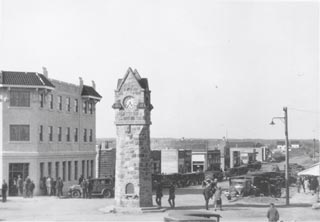
Main Street looking west
Circa 1930.
Photo: E.L. Cork
Browse Photos: Above (#6) | First (#1) • Table of Contents • Top •
Footnotes
Imperial Order Daughters of the Empire
This photo is one of the collection of pictures given to Herb Snyder by Edwina Harris, as alluded to in the above excerpt. The underside of the picture is signed by Earl L. Cork, and inscribed by Edwina’s mother:
Daughters of the Empire on the platform at the time of the unveiling of the Memorial Clock Tower
(also young Walter Huntingford)
They are, from left to right, back row, Mrs. McDougall (I think) Mrs. Brown, Mrs. Hudson, Mrs. Church, Mrs. Smith, Mrs. Welch, Mrs. Gregson, Mrs. Turner, Mrs. Pawling & Mother, Mrs. Lasell.
H. A. C.
The list of those present in this photo is based on that of the September, 2000 Star Chronicle 75th Anniversary Supplement, and not the inscription above. Also present, but not shown in this photograph were, Mrs. L.E. Laird and Mrs. G. Gregson. They do appear in the picture on page 16 of the Supplement
- • Table of Contents
- • Top
- Related:
- The Town Clock
- | Dedication
- ! We Remember
- • Top •
- WainwrightDistrict.org
The Camp Wainwright Story- | The Urban Stories
- | Wainwright Wildlife
Photos courtesy Erika Foley and Wainwright Museum
Copyright © 2000-2024 As Apply.- • from my ten fingers to the web